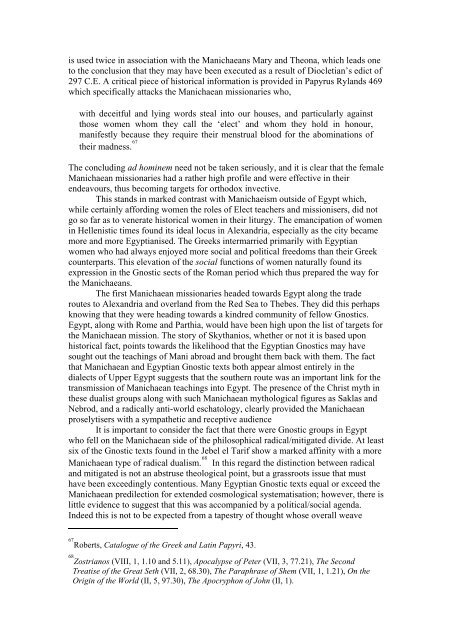THE EGYPTIAN FOUNDATIONS OF GNOSTIC THOUGHT
THE EGYPTIAN FOUNDATIONS OF GNOSTIC THOUGHT
THE EGYPTIAN FOUNDATIONS OF GNOSTIC THOUGHT
Create successful ePaper yourself
Turn your PDF publications into a flip-book with our unique Google optimized e-Paper software.
is used twice in association with the Manichaeans Mary and Theona, which leads one<br />
to the conclusion that they may have been executed as a result of Diocletian’s edict of<br />
297 C.E. A critical piece of historical information is provided in Papyrus Rylands 469<br />
which specifically attacks the Manichaean missionaries who,<br />
with deceitful and lying words steal into our houses, and particularly against<br />
those women whom they call the ‘elect’ and whom they hold in honour,<br />
manifestly because they require their menstrual blood for the abominations of<br />
their madness. 67<br />
The concluding ad hominem need not be taken seriously, and it is clear that the female<br />
Manichaean missionaries had a rather high profile and were effective in their<br />
endeavours, thus becoming targets for orthodox invective.<br />
This stands in marked contrast with Manichaeism outside of Egypt which,<br />
while certainly affording women the roles of Elect teachers and missionisers, did not<br />
go so far as to venerate historical women in their liturgy. The emancipation of women<br />
in Hellenistic times found its ideal locus in Alexandria, especially as the city became<br />
more and more Egyptianised. The Greeks intermarried primarily with Egyptian<br />
women who had always enjoyed more social and political freedoms than their Greek<br />
counterparts. This elevation of the social functions of women naturally found its<br />
expression in the Gnostic sects of the Roman period which thus prepared the way for<br />
the Manichaeans.<br />
The first Manichaean missionaries headed towards Egypt along the trade<br />
routes to Alexandria and overland from the Red Sea to Thebes. They did this perhaps<br />
knowing that they were heading towards a kindred community of fellow Gnostics.<br />
Egypt, along with Rome and Parthia, would have been high upon the list of targets for<br />
the Manichaean mission. The story of Skythanios, whether or not it is based upon<br />
historical fact, points towards the likelihood that the Egyptian Gnostics may have<br />
sought out the teachings of Mani abroad and brought them back with them. The fact<br />
that Manichaean and Egyptian Gnostic texts both appear almost entirely in the<br />
dialects of Upper Egypt suggests that the southern route was an important link for the<br />
transmission of Manichaean teachings into Egypt. The presence of the Christ myth in<br />
these dualist groups along with such Manichaean mythological figures as Saklas and<br />
Nebrod, and a radically anti-world eschatology, clearly provided the Manichaean<br />
proselytisers with a sympathetic and receptive audience<br />
It is important to consider the fact that there were Gnostic groups in Egypt<br />
who fell on the Manichaean side of the philosophical radical/mitigated divide. At least<br />
six of the Gnostic texts found in the Jebel el Tarif show a marked affinity with a more<br />
Manichaean type of radical dualism. 68<br />
In this regard the distinction between radical<br />
and mitigated is not an abstruse theological point, but a grassroots issue that must<br />
have been exceedingly contentious. Many Egyptian Gnostic texts equal or exceed the<br />
Manichaean predilection for extended cosmological systematisation; however, there is<br />
little evidence to suggest that this was accompanied by a political/social agenda.<br />
Indeed this is not to be expected from a tapestry of thought whose overall weave<br />
67<br />
Roberts, Catalogue of the Greek and Latin Papyri, 43.<br />
68<br />
Zostrianos (VIII, 1, 1.10 and 5.11), Apocalypse of Peter (VII, 3, 77.21), The Second<br />
Treatise of the Great Seth (VII, 2, 68.30), The Paraphrase of Shem (VII, 1, 1.21), On the<br />
Origin of the World (II, 5, 97.30), The Apocryphon of John (II, 1).










